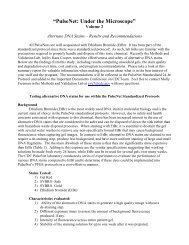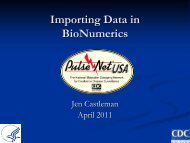- Page 1 and 2: PulseNet Quality Assurance/Quality
- Page 3 and 4: PNL21 PNL22 PNL23 PNL24 PNL25 PNL26
- Page 5 and 6: Quality Assurance / Quality Control
- Page 7 and 8: TABLE OF CONTENTS I. PREFACE II. IN
- Page 9 and 10: Molecular subtyping by PFGE is used
- Page 11 and 12: foodborne disease. The network perm
- Page 13 and 14: 4.1 The quality assurance/quality c
- Page 15: At least one person from each CDC P
- Page 19 and 20: STANDARD G.7 The laboratory shall m
- Page 21 and 22: STANDARD J.1 Each certified PulseNe
- Page 23 and 24: N. SAFETY M.1.1.2 The laboratory sh
- Page 25 and 26: APPENDIX B May 9, 2005 21
- Page 27 and 28: PNL10: Standard Operating Procedure
- Page 29 and 30: STANDARD OPERATING PROCEDURE FOR WR
- Page 31 and 32: STANDARD OPERATING PROCEDURE FOR WR
- Page 33 and 34: STANDARD OPERATING PROCEDURE FOR WR
- Page 35 and 36: STANDARD OPERATING PROCEDURE FOR PR
- Page 37 and 38: STANDARD OPERATING PROCEDURE FOR PR
- Page 39 and 40: STANDARD OPERATING PROCEDURE FOR PR
- Page 41 and 42: STANDARD OPERATING PROCEDURE FOR PR
- Page 43 and 44: STANDARD OPERATING PROCEDURE FOR PR
- Page 45 and 46: STANDARD OPERATING PROCEDURE FOR HA
- Page 47 and 48: STANDARD OPERATING PROCEDURE: DUTIE
- Page 49 and 50: STANDARD OPERATING PROCEDURE: DUTIE
- Page 51 and 52: STANDARD OPERATING PROCEDURE FOR PU
- Page 53 and 54: STANDARD OPERATING PROCEDURE FOR SH
- Page 55 and 56: STANDARD OPERATING PROCEDURE FOR SH
- Page 57 and 58: STANDARD OPERATING PROCEDURE FOR BE
- Page 59 and 60: STANDARD OPERATING PROCEDURE FOR BE
- Page 61 and 62: STANDARD OPERATING PROCEDURE FOR BE
- Page 63 and 64: STANDARD OPERATING PROCEDURE FOR BE
- Page 65 and 66: STANDARD OPERATING PROCEDURE FOR BE
- Page 67 and 68:
STANDARD OPERATING PROCEDURE FOR BE
- Page 69 and 70:
STANDARD OPERATING PROCEDURE FOR BE
- Page 71 and 72:
STANDARD OPERATING PROCEDURE FOR BE
- Page 73 and 74:
READING CONTROL SHEET FOR: GENERAL
- Page 75 and 76:
STANDARD OPERATING PROCEDURE FOR LA
- Page 77 and 78:
STANDARD OPERATING PROCEDURE FOR LA
- Page 79 and 80:
STANDARD OPERATING PROCEDURE FOR PR
- Page 81 and 82:
STANDARD OPERATING PROCEDURE FOR LA
- Page 83 and 84:
STANDARD OPERATING PROCEDURE FOR PU
- Page 85 and 86:
STANDARD OPERATING PROCEDURE FOR PU
- Page 87 and 88:
STANDARD OPERATING PROCEDURE FOR PU
- Page 89 and 90:
STANDARD OPERATING PROCEDURE FOR PU
- Page 91 and 92:
STANDARD OPERATING PROCEDURE FOR PU
- Page 93 and 94:
STANDARD OPERATING PROCEDURE FOR PU
- Page 95 and 96:
STANDARD OPERATING PROCEDURE FOR PU
- Page 97 and 98:
STANDARD OPERATING PROCEDURE FOR PU
- Page 99 and 100:
STANDARD OPERATING PROCEDURE FOR PU
- Page 101 and 102:
STANDARD OPERATING PROCEDURE FOR PU
- Page 103 and 104:
STANDARD OPERATING PROCEDURE FOR PU
- Page 105 and 106:
STANDARD OPERATING PROCEDURE FOR PU
- Page 107 and 108:
STANDARD OPERATING PROCEDURE FOR PU
- Page 109 and 110:
STANDARD OPERATING PROCEDURE FOR PU
- Page 111 and 112:
STANDARD OPERATING PROCEDURE FOR PU
- Page 113 and 114:
STANDARD OPERATING PROCEDURE FOR PU
- Page 115 and 116:
STANDARD OPERATING PROCEDURE FOR PU
- Page 117 and 118:
STANDARD OPERATING PROCEDURE FOR PU
- Page 119 and 120:
STANDARD OPERATING PROCEDURE FOR PU
- Page 121 and 122:
STANDARD OPERATING PROCEDURE FOR PF
- Page 123 and 124:
STANDARD OPERATING PROCEDURE FOR PF
- Page 125 and 126:
STANDARD OPERATING PROCEDURE FOR PF
- Page 127 and 128:
STANDARD OPERATING PROCEDURE FOR PF
- Page 129 and 130:
STANDARD OPERATING PROCEDURE FOR PF
- Page 131 and 132:
STANDARD OPERATING PROCEDURE FOR PF
- Page 133 and 134:
STANDARD OPERATING PROCEDURE FOR PF
- Page 135 and 136:
STANDARD OPERATING PROCEDURE FOR IM
- Page 137 and 138:
STANDARD OPERATING PROCEDURE FOR IM
- Page 139 and 140:
STANDARD OPERATING PROCEDURE FOR TH
- Page 141 and 142:
STANDARD OPERATING PROCEDURE FOR TH
- Page 143 and 144:
STANDARD OPERATION PROCEDURE FOR TH
- Page 145 and 146:
STANDARD OPERATING PROCEDURE FOR TH
- Page 147 and 148:
STANDARD OPERATING PROCEDURES FOR M
- Page 149 and 150:
STANDARD OPERATING PROCEDURES FOR M
- Page 151 and 152:
STANDARD OPERATING PROCEDURES FOR M
- Page 153 and 154:
STANDARD OPERATING PROCEDURE FOR MA
- Page 155 and 156:
STANDARD OPERATING PROCEDURE FOR WA
- Page 157 and 158:
STANDARD OPERATING PROCEDURE FOR TH
- Page 159 and 160:
STANDARD OPERATING PROCEDURE FOR TH
- Page 161 and 162:
STANDARD OPERATING PROCEDURE FOR EV
- Page 163 and 164:
STANDARD OPERATING PROCEDURE FOR EV
- Page 165 and 166:
STANDARD OPERATING PROCEDURE FOR PU
- Page 167 and 168:
STANDARD OPERATING PROCEDURE FOR PU
- Page 169 and 170:
STANDARD OPERATING PROCEDURE FOR PF
- Page 171 and 172:
STANDARD OPERATING PROCEDURE FOR PF
- Page 173 and 174:
STANDARD OPERATING PROCEDURE FOR PF
- Page 175 and 176:
STANDARD OPERATING PROCEDURE FOR PF
- Page 177 and 178:
STANDARD OPERATING PROCEDURE FOR PF
- Page 179 and 180:
STANDARD OPERATING PROCEDURE FOR PF
- Page 181 and 182:
LABORATORY STANDARD OPERATING PROCE
- Page 183 and 184:
LABORATORY STANDARD OPERATING PROCE
- Page 185 and 186:
LABORATORY STANDARD OPERATING PROCE
- Page 187 and 188:
LABORATORY STANDARD OPERATING PROCE
- Page 189 and 190:
LABORATORY STANDARD OPERATING PROCE
- Page 191 and 192:
LABORATORY STANDARD OPERATING PROCE
- Page 193 and 194:
LABORATORY STANDARD OPERATING PROCE
- Page 195 and 196:
LABORATORY STANDARD OPERATING PROCE
- Page 197 and 198:
LABORATORY STANDARD OPERATING PROCE
- Page 199 and 200:
LABORATORY STANDARD OPERATING PROCE
- Page 201 and 202:
LABORATORY STANDARD OPERATING PROCE
- Page 203 and 204:
STANDARD OPERATING PROCEDURE FOR AD
- Page 205 and 206:
LABORATORY STANDARD OPERATING PROCE
- Page 207 and 208:
LABORATORY STANDARD OPERATING PROCE
- Page 209 and 210:
LABORATORY STANDARD OPERATING PROCE
- Page 211 and 212:
LABORATORY STANDARD OPERATING PROCE
- Page 213 and 214:
LABORATORY STANDARD OPERATING PROCE
- Page 215 and 216:
LABORATORY STANDARD OPERATING PROCE
- Page 217 and 218:
LABORATORY STANDARD OPERATING PROCE
- Page 219 and 220:
LABORATORY STANDARD OPERATING PROCE
- Page 221 and 222:
LABORATORY STANDARD OPERATING PROCE
- Page 223 and 224:
LABORATORY STANDARD OPERATING PROCE
- Page 225 and 226:
STANDARD OPERATING PROCEDURE FOR PF
- Page 227 and 228:
STANDARD OPERATING PROCEDURE FOR PF
- Page 229 and 230:
STANDARD OPERATING PROCEDURE FOR PF
- Page 231 and 232:
STANDARD OPERATING PROCEDURE FOR PF
- Page 233 and 234:
STANDARD OPERATING PROCEDURE FOR PF
- Page 235 and 236:
STANDARD OPERATING PROCEDURE FOR PF
- Page 237 and 238:
LABORATORY STANDARD OPERATING PROCE
- Page 239 and 240:
LABORATORY STANDARD OPERATING PROCE
- Page 241 and 242:
LABORATORY STANDARD OPERATING PROCE
- Page 243 and 244:
LABORATORY STANDARD OPERATING PROCE
- Page 245 and 246:
LABORATORY STANDARD OPERATING PROCE
- Page 247 and 248:
LABORATORY STANDARD OPERATING PROCE
- Page 249 and 250:
LABORATORY STANDARD OPERATING PROCE
- Page 251 and 252:
LABORATORY STANDARD OPERATING PROCE
- Page 253 and 254:
LABORATORY STANDARD OPERATING PROCE
- Page 255 and 256:
LABORATORY STANDARD OPERATING PROCE
- Page 257 and 258:
LABORATORY STANDARD OPERATING PROCE
- Page 259 and 260:
LABORATORY STANDARD OPERATING PROCE
- Page 261 and 262:
LABORATORY STANDARD OPERATING PROCE
- Page 263 and 264:
LABORATORY STANDARD OPERATING PROCE
- Page 265 and 266:
LABORATORY STANDARD OPERATING PROCE
- Page 267 and 268:
LABORATORY STANDARD OPERATING PROCE
- Page 269 and 270:
LABORATORY STANDARD OPERATING PROCE
- Page 271 and 272:
STANDARD OPERATING PROCEDURE FOR PU
- Page 273 and 274:
STANDARD OPERATING PROCEDURE FOR PU
- Page 275 and 276:
STANDARD OPERATING PROCEDURE FOR PU
- Page 277 and 278:
STANDARD OPERATING PROCEDURE FOR PU
- Page 279 and 280:
STANDARD OPERATING PROCEDURE FOR PU
- Page 281 and 282:
STANDARD OPERATING PROCEDURE FOR PU
- Page 283 and 284:
STANDARD OPERATING PROCEDURE FOR PU
- Page 285 and 286:
LABORATORY STANDARD OPERATING PROCE
- Page 287 and 288:
LABORATORY STANDARD OPERATING PROCE
- Page 289 and 290:
LABORATORY STANDARD OPERATING PROCE
- Page 291 and 292:
LABORATORY STANDARD OPERATING PROCE
- Page 293 and 294:
LABORATORY STANDARD OPERATING PROCE
- Page 295 and 296:
LABORATORY STANDARD OPERATING PROCE
- Page 297 and 298:
LABORATORY STANDARD OPERATING PROCE
- Page 299 and 300:
LABORATORY STANDARD OPERATING PROCE
- Page 301 and 302:
LABORATORY STANDARD OPERATING PROCE
- Page 303 and 304:
LABORATORY STANDARD OPERATING PROCE
- Page 305 and 306:
LABORATORY STANDARD OPERATING PROCE
- Page 307 and 308:
LABORATORY STANDARD OPERATING PROCE
- Page 309 and 310:
LABORATORY STANDARD OPERATING PROCE
- Page 311 and 312:
LABORATORY STANDARD OPERATING PROCE
- Page 313 and 314:
LABORATORY STANDARD OPERATING PROCE
- Page 315 and 316:
LABORATORY STANDARD OPERATING PROCE
- Page 317 and 318:
LABORATORY STANDARD OPERATING PROCE
- Page 319 and 320:
LABORATORY STANDARD OPERATING PROCE










